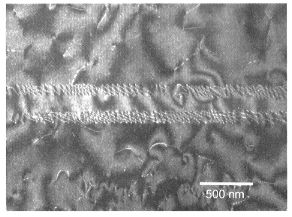

According to current concepts of past climatic changes, impact-induced decomposition reactions of volatile-rich minerals have largely influenced the evolution of the Earth´s atmosphere. The devolatilization of carbonates and sulfates has played a particular role in the mass extinction at the K/T boundary because the target area of the Chicxulub impact was an anhydrite-rich carbonate platform. Therefore, large quantities of CO2 and SO2 are expected to have been released by the impact, causing a sudden perturbance of the composition of the atmosphere. As differently designed shock experiments and thermodynamical calculations yield variable results on the threshold conditions of degassing, the amount of CO2 released from shocked carbonates is still uncertain. It is, however, generally accepted that porosity exerts a strong control on shock and post-shock temperatures, and hence, on threshold temperatures of CO2 release.
To study the degassing behaviour of calcite, we performed two types of experiments: (1) high-explosive shock experiments at high pressures (64, 85, and > 100 GPa) using single crystal calcite and compacted calcite powder, and (2) rapid decompression in a multianvil apparatus.
After shock experiments, single crystal calcite is pervaded by a network
of irregular cracks. FE-SEM imaging reveals the presence of numerous bubbles
and vesicles on the surface of cracks with diameters in the sub-µm
range. Porous calcite samples developed spherically shaped foamy aggregates,
indicating total shock-melting, and enhanced mobilization of a gaseous
species. X-ray diffraction and TEM microanalyses failed to detect CaO,
the expected solid residue in case of CO2 release. Our interpretation
is, hence, that these textures are produced during transient PT conditions
in the stability field liquid + vapor (CaCO3). Post-shock temperatures
were possibly too low to reach the stability field of CaO (solid) + CO2
(vapor). X-ray investigations reveal furthermore a significant decrease
of average grain size in porous samples, which can be attributed to rapid
crystallization of calcite crystals from melt. This interpretation is supported
by the TEM observation that porous samples are undeformed, whereas shocked
single-crystal calcite contains mechanical twins and numerous dislocations
(Fig. 3.4-1).
 |
|
|
(2) The use of a multianvil apparatus represents a new experimental approach to simulate the P-T path of shock decompression at similar timescales as expected in nature. Calcite powder, loaded to a static pressure of 25 GPa at 2400°C, was decompressed and quenched to ambient pressure and temperature within three seconds. This is approximately the same time scale expected for the pressure pulse of the Chicxulub impact. A significantly increased mean grain size of the calcite was the only clear effect. This is attributed to grain coarsening before the start of decompression. From the lack of any signs of decomposition, we conclude that the quantity of CO2 release in impact processes is often overestimated. Similar experiments on the decompression behaviour of anhydrite are planned as a test for the possible release of sulfate species.

Tel: +49-(0) 921 55 3700 / 3766, Fax: +49-(0) 921 55 3769, E-mail: bayerisches.geoinstitut(at)uni-bayreuth.de
 Previous page
Previous page